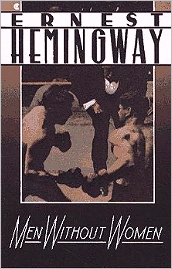 |
"The Killers"Ernest Hemingway |
|---|
 |
"The Killers"Ernest Hemingway |
|---|
"The Killers" is Ernest Hemingway's one perfectly realized piece in the hard-boiled vein. Two hired gunmen enter a diner to wait for the nightly appearance of "the Swede," whom they have been paid to kill. When the Swede doesn't show, the zombie-like killers go to his rented room, to find him lying on his bed in the dark, waiting to give himself up to their dark mission. The killers shoot him and then leave town, as quickly and as quietly as they arrived.
Hemingway tells nothing about the Swede's background, or about his feelings. The character is seen only from the outside, as a starlingly passive victim. And yet the story reverberates with a sense of powerful, unexpressed feeling. Hemingway's clenched, metallic dialogue--which would become the standard "voice" of noir--and his terse scene-setting contain a palpitating subtext. The Swede's existential resignation, the character's despair and world-weariness, are ingrained in the willed, deadly flatness of the language.
Nick opened the door and went into the room, Ole Andreson was lying on the bed with all his clothes on. He had been a heavyweight prizejsghter and he was too longfor the bed. He lay with his head on two pillows. He did not look at Nick.
"What was it?" he asked.
"I was up at Henry's, " Nick said, "and twofellows came in and tied up me and the cook, and they said they were going to kill you."
It sounded silly when he said it. Ole Andreson said nothing.
"Thanks for coming to tell me about it. "That's all right."
Nick looked at the big man lying on the bed.
"Don't you want me to go and see the police?"
"No," Ole Andreson said. "That wouldn't do any good."
"Isn't there something I could do?"
"No. There ain't anything to do.
"Maybe it was just a bluff."
"No. It ain't just a bluff."
Ole Andreson rolled over toward the wall.The short, simple sentences, the repetitions, are thick with menace and implication. Hemingway uses the colloquial style more knowingly and for deeper purposes than the "poets of the tabloid murder," but the high and low versions of the hard-boiled manner share a world view as well as a use of language. This view is one whose impact was felt beyond just the literature of the day, inspiring the visual arts as well.
The American painter Edward Hopper, who had painted such pre-noir canvases as Drug Store, Automat, and Night Windows in the 1920s, is probably best known for Nighthawks (1942), an image that could easily be mistaken for a film noir lobby card. According to Hopper biographer Gail Levin, the figures in Nighthawks--a starkly realistic painting of three patrons (a couple and a solitary man with his back to the viewer) and a uniformed counterman in a late night diner--was inspired by Hemingway's "The Killers."
The 1946 film adaptation of Hemingway's short story, The Killers, adds well over an hour of new material to the original tale. While director Robert Siodmak, star Burt Lancaster, and an outstanding supporting cast are faithful to Hemingway's work, his story takes up only about 15 minutes of screen time. Hemingway's bruisingly concise dialogue makes the opening sequence in the diner quite unnerving.
--FOSTER HIRSCH, from Film Noir
The Dark Side of the Screen.
A selection of "The Killers" related fiction.
|
Find "The Killers" on eBay.com
A selection of "The Killers" related non-fiction.
|
|
home: The Noir 'net |
back to: NOIR LITERATURE |
|
Any comments, additions or suggestions
should be adressed to: The Noir 'net / Eric B. Olsen / ericbolsen@juno.com |
Other Web Sites:
History of Horror Hard Bop Homepage The War Film Web Author Eric B. Olsen |